#canaanite gods
Explore tagged Tumblr posts
Text
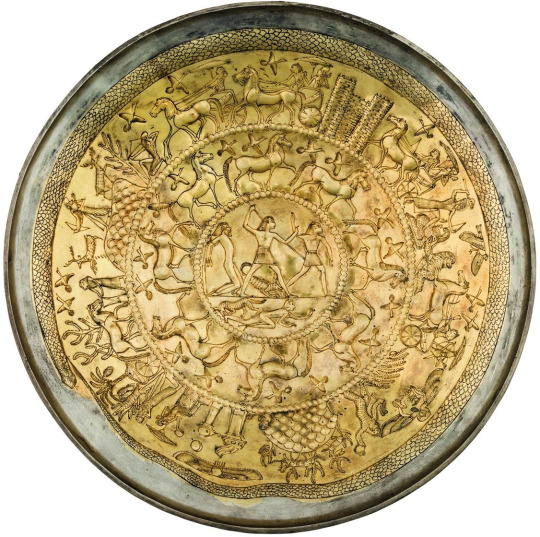
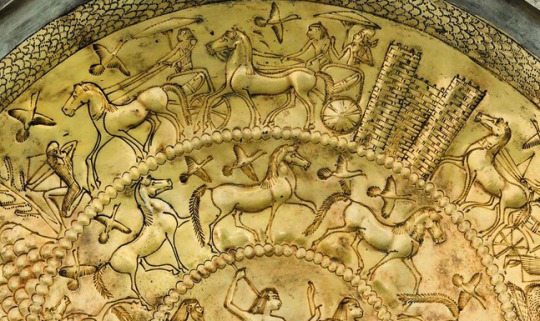
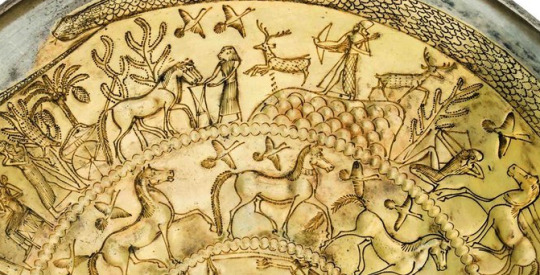
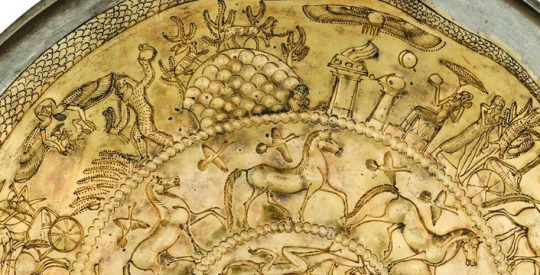
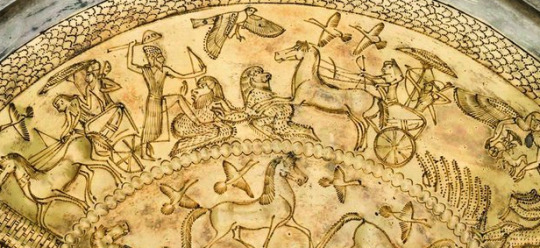
Phoenician Bowl with encircling Serpent Bernardini Tomb (Palestrina, Italy) c. 700 BCE The National Etruscan Museum of Villa Giulia Rome, Italy
#cyprus#rome#italy#egypt#egyptian gods#canaan#canaanite gods#phoenicia#phoenician gods#aram#aramean gods#syria#syrian gods#levantine gods#mesopotamia#mesopotamian gods#pagan gods#polytheism#archeology#magic#witchcraft#witchblr#paganblr#occult#uroboros#ouroboros#warfare#hunting#soldiers#birds
1K notes
·
View notes
Text

“Don’t buy me then.”
And that was it. No ‘I’m sorry for asking,’ no ‘I understand,’ not even a ‘fuck you.’ No, Yahweh had insisted upon Hadad that a way was possible even if he didn’t know how it would be so, face firm and filled with resolve. The boss, in turn, tries to resist letting his jaw drop at the audacity as he confesses to himself he quite likes the attitude, instead fixes his own expression into one of amusement with the crooked little smile back in place.
“Kid, I ain’t tryna treat you like you’re stupid or anything, but uh, how do you suppose I go and ‘break’ you out of El’s contract if not buy ‘ya? Money is usually how it goes when you sign up to be a call girl.”
I know, Yahweh murmurs, his face unrelenting in its resolve. “Look, Hadad, is it? Listen, I signed up under him ‘cause he made it sound like I didn’t have to rent my body out to strangers as long as I kept them good company, but he’s starting to threaten me with work I’m not comfortable with and it’s not worth it any longer.”
I see , Hadad hums under his breath, expression softening. Had anybody else asked this of him, he thinks, he would’ve damn well thrown them out of the club with his bare hands. Yet there is something here in that dazzling gaze that affixes him so, makes him want to act like a stupid ass Romeo who’s going to come in and save the day. That’s why the next thing out of his mouth surprises even him:
“If you’ve read the contract in full, then you must know there are a few clauses that even he will concede to.”
Yahweh nods again, blinks a couple of times before bearing the hint of a smile. “Besides die, I need to either go back to school, have a child, or get married.”
Hadad’s gaze flutters to a half-lidded gaze, lips twitching back into a crooked smile. “Then just go back to school, kid, you don’t need my favor for that.”
The call girl snorts, face crinkling into what the boss will learn is his way of being a brat. “Already graduated with a bachelor’s or else I would.”
Too bad, Hadad teases, smile widening as his eyes twinkle. His next thought was to blurt out having a child, but Yahweh would either have to go fuck the proper hole or adopt, both options he didn’t seem inclined towards.
Well, there' s only one thing left to do, a fact that has him raising a brow while the glint in his eyes teases Yahweh something fierce. “I’m not marriage material, trust me. I get jealous easy, I’m belligerent as fuck, and I sure as Hell ain’t good at keepin’ it in my pants.”
Yahweh’s eyes flit down real slow and real cool to Hadad’s mouth, wonders how grand of a kisser he must be if he can’t ’keep it in his pants.’ “Well, Hadad, I can’t cook to save my life, I don’t mind my tongue, and I’m afraid I get awfully jealous myself. . .”
What it is about those words that gets Hadad’s heart racing, he could not say, just knows his eyes are also wandering down to Yahweh’s lips as he imagines the tickle of them against his neck in the morning as they share the bed, in the day when they embrace before he heads off to work, or in the night against his own lips while Hadad pins him into the mattress. For the first time in his life, the prospect of being wed is not something that repulses him but makes him desire, instead.
Meet The Artist / Here's the Full Series
#bible fandom#bible fanfiction#canaanite gods#yahweh/ba'al#gay#writers on tumblr#it's heresy hours boys
26 notes
·
View notes
Text
So who is Baal?
Baal or Baʻal, was a title and honorific meaning 'owner', 'lord' in the Northwest Semitic languages spoken in the Levant during antiquity.
Baal is a God of fertility, weather, rain, wind, lightning, seasons, war, sailors and so on.
Baal worship is also called Baalism.
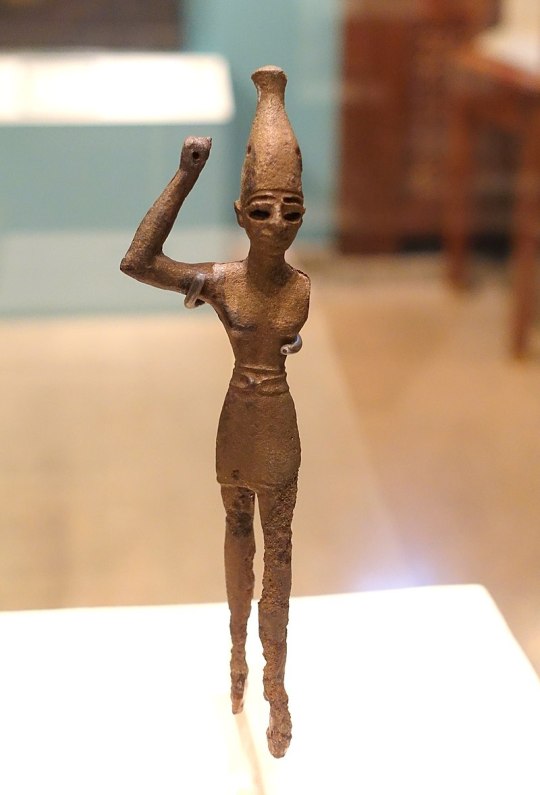
Solid cast bronze of a votive figurine representing the god Baal discovered at Tel Megiddo, dating to the mid-2nd millennium BC.
His holy symbols are bull, ram and thunderbolt.
Baal was worshipped in ancient Syria, especially Halab, near, around and at Ugarit, Canaan, North Africa and Middle Kingdom of Egypt.
Baʿal is well-attested in surviving inscriptions and was popular in theophoric names throughout the Levant but he is usually mentioned along with other gods, "his own field of action being seldom defined". Nonetheless, Ugaritic records show him as a weather god, with particular power over lightning, wind, rain, and fertility. The dry summers of the area were explained as Baʿal's time in the underworld and his return in autumn was said to cause the storms which revived the land. Thus, the worship of Baʿal in Canaan—where he eventually supplanted El as the leader of the gods and patron of kingship—was connected to the regions' dependence on rainfall for its agriculture, unlike Egypt and Mesopotamia, which focused on irrigation from their major rivers. Anxiety about the availability of water for crops and trees increased the importance of his cult, which focused attention on his role as a rain god. He was also called upon during battle, showing that he was thought to intervene actively in the world of man, unlike the more aloof El. The Lebanese city of Baalbeck was named after Baal.
The Baʿal of Ugarit was the epithet of Hadad but as the time passed, the epithet became the god's name while Hadad became the epithet. Baʿal was usually said to be the son of Dagan, but appears as one of the sons of El in Ugaritic sources. Both Baʿal and El were associated with the bull in Ugaritic texts, as it symbolized both strength and fertility. He held special enmity against snakes, both on their own and as representatives of Yammu (lit. "Sea"), the Canaanite sea god and river god. He fought the Tannin (Tunnanu), the "Twisted Serpent" (Bṭn ʿqltn), "Lotan the Fugitive Serpent" (Ltn Bṭn Brḥ, the biblical Leviathan), and the "Mighty One with Seven Heads" (Šlyṭ D.šbʿt Rašm). Baʿal's conflict with Yammu is now generally regarded as the prototype of the vision recorded in the 7th chapter of the biblicalBook of Daniel. As vanquisher of the sea, Baʿal was regarded by the Canaanites and Phoenicians as the patron of sailors and sea-going merchants. As vanquisher of Mot, the Canaanite death god, he was known as Baʿal Rāpiʾuma (Bʿl Rpu) and regarded as the leader of the Rephaim (Rpum), the ancestral spirits, particularly those of ruling dynasties.
From Canaan, worship of Baʿal spread to Egypt by the Middle Kingdom and throughout the Mediterranean following the waves of Phoenician colonization in the early 1st millennium BCE. He was described with diverse epithets and, before Ugarit was rediscovered, it was supposed that these referred to distinct local gods. However, as explained by Day, the texts at Ugarit revealed that they were considered "local manifestations of this particular deity, analogous to the local manifestations of the Virgin Mary in the Roman Catholic Church". In those inscriptions, he is frequently described as "Victorious Baʿal" (Aliyn or ẢlỈyn Baʿal), "Mightiest one" (Aliy or ʿAly) or "Mightiest of the Heroes" (Aliy Qrdm), "The Powerful One" (Dmrn), and in his role as patron of the city "Baʿal of Ugarit" (Baʿal Ugarit). As Baʿal Zaphon (Baʿal Ṣapunu), he was particularly associated with his palace atop Jebel Aqra (the ancient Mount Ṣapānu and classical Mons Casius). He is also mentioned as "Winged Baʿal" (Bʿl Knp) and "Baʿal of the Arrows" (Bʿl Ḥẓ). Phoenician and Aramaic inscriptions describe "Baʿal of the Mace" (Bʿl Krntryš), "Baʿal of the Lebanon" (Bʿl Lbnn), "Baʿal of Sidon" (Bʿl Ṣdn), Bʿl Ṣmd, "Baʿal of the Heavens" (Baʿal Shamem or Shamayin), Baʿal ʾAddir (Bʿl ʾdr), Baʿal Hammon (Baʿal Ḥamon), Bʿl Mgnm.
The epithet Hammon is obscure. Most often, it is connected with the NW Semitic ḥammān ("brazier") and associated with a role as a sun god. Renan and Gibson linked it to Hammon (modern Umm el-‘Amed between Tyre in Lebanon and Acre in Israel) and Cross and Lipiński to Haman or Khamōn, the classical Mount Amanus and modern Nur Mountains, which separate northern Syria from southeastern Cilicia.
The major source of our direct knowledge of this Canaanite deity comes from the Ras Shamra tablets, discovered in northern Syria in 1958, which record fragments of a mythological story known to scholars as the Baal Cycle. Here, he earns his position as the champion and ruler of the gods. The fragmentary text seems to indicate a feud between him and his father El as background. El chooses the fearsome sea god Yam to reign as king of the gods. Yam rules harshly, and the other deities cry out to Ashera, called Lady of the Sea, to aid. Ashera offers herself as a sacrifice if Yam will ease his grip on her children. He agrees, but Baal opposes such a scheme and boldly declares he will defeat Yam even though El declares that he must subject himself to Yam.
With the aid of magical weapons given to him by the divine craftsman Kothar-wa-Khasis, Baal defeats Yam and is declared victorious. He then builds a house on Mount Saphon, today known as Jebel al-Aqra. (This mountain, 1780 meters high, stands only 15 km north of the site of Ugarit, clearly visible from the city itself.)
Lo, also it is the time of His rain. Baal sets the season, And gives forth His voice from the clouds. He flashes lightning to the earth. As a house of cedars let Him complete it, Or a house of bricks let Him erect it! Let it be told to Aliyan Baal: 'The mountains will bring Thee much silver. The hills, the choicest of gold; The mines will bring Thee precious stones, And build a house of silver and gold. A house of lapis gems!'
However, the god of the underworld, Mot, soon lures Baal to his death, spelling ruin for the land. His sister Anat retrieves his body and begs Mot to revive him. When her pleas are rebuffed, Anat assaults Mot, ripping him to pieces and scattering his remains like fertilizer over the fields.
El, in the meantime, has had a dream in which fertility returned to the land, suggesting that Baal was not indeed dead. Eventually he is restored. However, Mot too has revived and mounts a new attack against him.
They shake each other like Gemar-beasts, Mavet [Mot] is strong, Baal is strong. They gore each other like buffaloes, Mavet is strong, Baal is strong. They bite like serpents, Mavet is strong, Baal is strong. They kick like racing beasts, Mavet is down. Baal is down.
After this titanic battle, neither side has completely prevailed. Knowing that the other gods now support Baal and fearing El's wrath, Mot finally bows before him, leaving him in possession of the land and the undisputed regent of the gods.
Baal is thus the archetypal fertility deity. His death signals drought and his resurrection, and brings both rain and new life. He is also the vanquisher of death. His role as a maker of rain would be particularly important in the relatively arid area of Palestine, where no mighty river such as the Euphrates or the Nile existed.
#baal#baal deity#baalism#canaanite gods#canaan#ancient history#ancient gods#history#ancient god#spiritual#deity#deities#religious#religion#religia#ancient religion#ancient world#gods#myth#mythos#ancient myths#mythology#mythology and folklore#myths#Canaanite religion#world religions#world history#ancient mythology
30 notes
·
View notes
Text










Shahar and Shalim = Twin Gods of Dusk, Day Cycle Dawn and Dusk, children of El and Asherah
#history#God of dusk#God of dawn#Canaanite gods#canaanite religion#canaanite mythology#Gods#Phoenician god#mythology#Shalim#Shahar#shalim#sharar#my favorite
19 notes
·
View notes
Text

[CANAAN] Anat and two of her half-sisters, Shapash, the goddess of the sun, and Astarte, goddess of sexual love and fertility. All three have different mothers, and each inherit her beauty, but all possess the yellow-gold eyes and frightening power of their father, Bull El.
In my version El is very much a girldad and spoils his daughters so I wanted to draw the big 3 girls together. Asherah and El next mayhaps. Anat's design is Canaanite-Palestinian, Shapash is northern Palestine and Lebanon + Canaan, Astarte has a lot of Egyptian influence mixed with Canaanite.
#canaan#canaanite god#canaanite myth#mythology#baal cycle#anat#goddess anat#shapash#astarte#ashtart#anath#my art#doodl
240 notes
·
View notes
Text









cannanite mythology: resheph
resheph is the god of the plague and of the underworld, the companion of anath. he was also a war god and was thus represented as a bearded man brandishing an ax, holding a shield, and wearing a tall, pointed headdress with a goat’s or gazelle’s head on his forehead.
#canaanite mythology#resheph#also egyptian myth#canaanite myth#mythologyedit#canaanitemythologyedit#mythedit#*mine*#gods and goddesses
204 notes
·
View notes
Text
Lucifer - Not Quite Like You Think

Alright, @greenpeacocks asked about the Ars Goetica and Lucifer. And I will do this in two different blogs, because both are more than enough for me to ramble on about for like 1k words. lol Because, oh boy, demonology and history are so interesting to cross over.
I will start with dear Lucifer.
Let me start with one question: Where does Lucifer come from? And what was he?
Chances are, you said, Lucifer was an angel who rebelled against God (with a capital-G) and because of that was cast out of heaven together with other angels, who rebelled. And now he either has become Satan, or is one of many demons/fallen angels in hell.
And with that you would be wrong.
See, something you have to understand about the Lucifer story, as written in the bible, is, that the Abrahamitic religions - as long as they had been Abrahamitic - had been monotheistic. Yes. However this religion came out of the Canaanite religion, which was a polytheistic religion, that eventually went back to Sumerian religion. I will for now not go into detail how that polytheistic religion became monotheistic. The tl;dr version of what religious scientists right now believe is this: There was an Egyptian weather god called Yahweh, that got imported into the Canaanite religion, where he eventually merged with the god Ba'al. One of the Canaanite tribes had this Yahweh/Ba'al eventually merge with the highest god of that religion, El, also known as Elohim. Which is why the bible uses both names for God. The last bit - him merging with El - is the important part.
Because in the Canaanite religion (probably going back to the Sumerian myths) there was a myth about the Morning God, Helel or Helal, who was the manifestation of Venus (aka the Morning Star), challenging El's position as the upper god of this pantheon. He was prideful because he was shining brighter than all the other gods, but for this challenge got eventually exiled from the realm of the gods for a while.
This does sound a bit familiar, right?
Well, what if I tell you, that in the untranslated version of the Bible the supposedly "rebelling angel" was actually called Helel?
Yeah, for some reason this big of old mythology just happened to survive into the bible. Helel was there, never being fully defined as an angel, but just as "a bright being of the sky", which was eventually by scholars interpreted as an angel.
"But," I hear you asking, "why do we call him Lucifer?"
Well, this is because of the Latin translation of the bible. See, when the bible - which originally was partly written in Greek, and partly in Hebrew - got fully translated into Latin, the people translating it realized that the name "Helel" did not mean anything to their audience. However, they were still aware of the origin of this story, and new that Helel was a name for the god of the Morning Star. So they just used the Roman name for the god of the Morning Star, son of the Aurora: Lucifer. A god, that in Roman mythology was not really meaningful. He shows up in a couple of Roman manuscripts that we have, but does not appear to have been prayed to a whole lot. And they put this name into the bible for this god/angel trying to take God's throne.
So, yeah. That is how we got Lucifer. A left over from an old religion.
Now, some of you might also have heard that Lucifer was originally a dragon. And of course, most of you think of Lucifer as Satan or the Devil. Why is that?
Well, both of these are related. Satan is twice described as a dragon in some parts of the bible. And in one of the scenes Satan is also cast down from the heaven. Now, Lucifer is not mentioned anywhere near that - but people went: "Huh, someone gets thrown down from heaven, so I guess that only ever happened once, so Lucifer and Satan are the same person and they are both an angel and a dragon!"
Whether or not Satan and Lucifer are eventually portrayed as the same character is very depedend on what source you might use. (Note, demonology developed during the second half of the middle ages and came up with a whole of its original rules for both demons and the hell or hells. In fact, a lot of depictions of hell and evil gods we see in modern fantasy and horror media, like DnD, Castlevania and so on, is more based on this demonology, than actual religious doctrine.) In a lot of Demonology they are differentiated, but once you are go more into Catholic depictions, they often get merged into one character.
I will probably write about the Ars Goetia later this week or on the weekend. Because that needs a whole lot of context. xD
#paradise lost#bible#bible study#christian mythology#abrahamitic religion#canaanite culture#sumerian mythology#sumerian gods#egyptian mythology#ancient religion#ancient history#lucifer#helel#hazbin hotel#helluva boss#angel sanctuary#castlevania#dungeons & dragons#dante's inferno
17 notes
·
View notes
Text
girl i don’t know how to tell you this but the prince of egypt isn’t contemporary zionist propaganda it is a retelling of the first half of the book of exodus. which is. sorry to tell you this. SO MUCH FUCKING OLDER than zionism.
#like does zionism have its roots in the messages that STARTED in the hebrew bible?? absolutely. the idea of a promised hand that the hebrews#are sanctioned by God to take over by any means necessary which involves the massacre of the indigenous canaanites ? yeah man like. yeah#obviously that shit has impacted and formed modern zionism. the book of joshua? like yeah no shit.#but the prince of egypt isn’t. like.#like yes it still has those qualities#but it isn’t zionist propaganda. it’s a relatively faithful adaptation of an ancient literary text#the person was like ummmm it’s problematic bc the first song has the lines deliver us to the promised land and that’s so clearly zionist#propaganda#BABY GIRL I IMPLORE YOU. AT LEAST READ A WILIPEDIA ARTICLE ABOUT LIKE. THE BASICS OF EARLY JUDAISM#irs legit so embarrassing for them
19 notes
·
View notes
Note
How it's feel working with asherah and what make you interested working with her
Asherah or Ashirat is a Goddess of fertility, love and life and the wife of the chief God El Elyon in the Canaanite pantheon, quite similar to Ashtar without the warlike associations. In fact, in my own gnosis (and in most Canaan interpretations) I consider Ashirat to the mother of Ashtar and Anat, that is the holy nurturing mother as opposed to the sexy sex feminine rage archetype that encompasses other aspects of Ashtar and Anat as love Goddesses.
Attar and Anat, while love deities, are not mother goddesses. They likely took their fertility aspects from their mother without becoming mother goddesses themselves
Many people have syncretized these three goddesses, especially in regards to Astarte (People say that Ashirat is Astarte rather than her mother) but I prefer to keep them separate. Anat’s individuality as a deity of savagery, war and violence and Attar’s individuality as a deity of carnal sex and pleasure feel distinct from Ashirat’s persona as a nurturing mother goddess. I see her as my primary “Mother Nature” deity, although she is more than Mother Earth, she is the mother of Mother Earth, and the sun and moon. But that’s all up to interpretation. (and they’re all derived from Inanna in some way or another)
Because my gnosis syncretizes Attar, Astarte, Aphrodite, and Lucifer, and Lucifer is my patron, Ashirat is a very important Goddess to me as the mother of Venus. I actually started recognizing Ashirat far before I even knew about Ashtar.
As the Asherim pole and the lady of the primordial sea she can be considered quite similar to Aphrodite, as she was one of the influences that came to establish the persona of Aphrodite. While her daughters Attar and Anat went on to establish the more carnal and aesthetic aspects of beauty, sex, and love, as well as the destructive egotistical aspects, Ashirat embodied the beauty, sex, and love that created the cosmos and heavens.
(The children of Gods are usually the Gods of more specific things in that domain. From Aphrodite and Ares we got Eros (Cupid), from Eros and Psyche we got Voluptas who represents physical pleasure and bliss. So from Ashirat and El we get Ashtar and Anat, who represent more specific aspects of love and beauty like carnal lust and revenge- violence born from love.)
As the wife of El (or Yahweh, or Ba’al… scandalous! Isn’t it so annoying when your boyfriends fight?) she is the mother of all heavenly hosts and sons, and I consider her to be the mother of all the Archangels. There is nothing to confirm this but I believe her 70, 77, or 88 sons to have been those angels. Due to her associations with Ba’al I wouldn’t be surprised if she was also the mother of a few daemon as well.
When I first began my work as a practitioner I was mentored by Archangel Jophiel, who directly lead me into Ashirat and gave grace and full authority to her. I believe she has that same authority over all angels and demons of El Elyon.
She has dominion over all animals of nature and life giving forces (water).
As a daily act of devotion I offer her clean water and tend to plants or help out animals (feeding birds, leaving water out for strays) I also take baths whenever I do rituals with her.
She often demands honour is also given to her consort in the same way that Hera demands her devotees also worship Zeus, but you can also easily worship her without having a defined father deity, lord knows she’s shared the stage with one too many egotistical men but that’s neither here nor there lol. In my experiences she has encouraged me to make peace with the divine father, and in my searching I found Ra and Anu, and that seemed to be good enough for her. She has been very warm towards the devotees of her daughters and anyone who works with any of her sons.
The only pet peeve of her that I’ve discovered is honoring her while dehydrated. Drink your water babes she worked so hard on it.
#witchcraft#magick#paganism#pagan#occultism#witch community#witch aesthetic#witchblr#demonology#grimoire#asherah#astarte#ishtar#inanna#lucifer#luciferian#canaan#canaanites#mythology#wife of god#deity work#deity worship#attar
40 notes
·
View notes
Text
Two prayers from ancient Ugarit
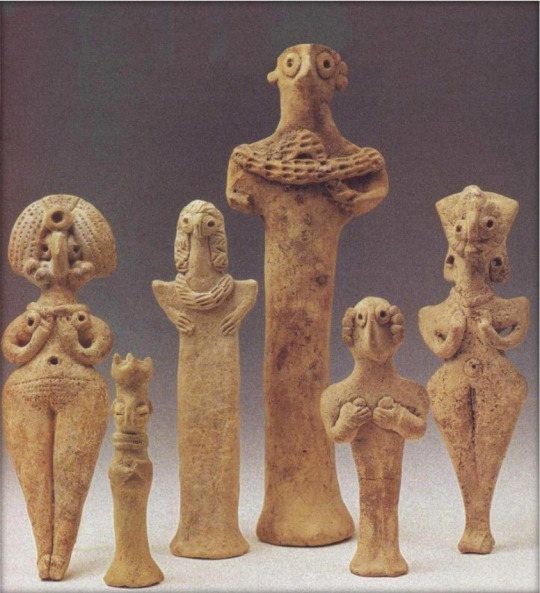
Various “Teraphim” figures representing deities for devotional purposes from ancient Canaan/Judah. Photo from “Exhibit from the Bible Lands Museum” (Biblical Archaeology Review Vol. 25:5 (Sep.–Oct. 2000), p. 22). Source: Fertility Goddesses from the Ancient Near East (Mar. 2000) by Wanda Roux, https://www.semanticscholar.org/paper/Fertility-goddesses-from-the-Ancient-Near-East-Roux/218a301d5b1f807dd2324e37257cc817912ceeed.
Shulmu 𒁲𒈬 to all! These are a couple more Ugaritic prayers I've given my own take on and filled in blanks based on scholarly texts. The first of these is addressed to 𒀭Prince Ba'al and is found appended to a bimonthly itinerary of Temple rituals classified as KTU 1.119 (=RS 24.266). My source for the text is Pardee 2002 (I mention these works often enough I figure I'll probably make a bibliography), pp. 50–53, 149–50 and the translation in Wyatt 2002, pp. 416–22. The next prayer, found on tablet KTU 1.65 (Wyatt 2002, pp. 363–65), also has a liturgical character and appears to have originally been concerned with the wellbeing of the a City of Ugarit. I've tried to adjust language in both prayers to make them flow as well as possible in English with a distinct ancient tone and I really hope you like what I've got here.
Prayer to Ba'al for Protection
When a terrible foe storms your gate,
a marauder dashes your walls,
You shall lift up your eyes to 𒀭Ba'al and say:
“O 𒀭Ba'al, if You drive the terrible foe from our gate,
“banish the marauder from our walls,
“an offering, O 𒀭Ba'al, we shall sanctify,
“a vow, O 𒀭Ba'al, we shall fulfill;
“a heritage, O 𒀭Ba'al, we shall sanctify,
“a Propitiation, O 𒀭Ba'al, we shall fulfill,
“a feast, O 𒀭Ba'al, we shall offer;
“to the Sanctuary, O 𒀭Ba'al, we shall ascend,
“the paths of the Temple, O 𒀭Ba'al, we shall follow.”
and 𒀭Ba'al will hear your prayer:
He will drive the terrible foe from your gate,
banish the marauder from your walls.
Prayer to El and the Family of the Gods
O Gods of the House of 𒀭El,
Family of the Gods,
Assembly of the Gods,
𒀭Thukamuna and 𒀭Shunama.
O 𒀭EI and 𒀭Ashirat,
Show us grace, O 𒀭El,
Come to our assistance, O 𒀭El,
Grant us peace, O 𒀭EI.
𒀭EI, come close,
𒀭EI, be our guard,
for the love of 𒀭Ba'al of 𒀭Sapon,
for the hope in 𒀭Ba'al of Ugarit.
By the Holy Spear,
by the Holy Axe,
by the Holy Mace,
by the Holy Javelin.
By the Holy Burnt-Offering,
by the Holy Perpetual Offering,
by the Holy Morning Offering,
by the Holy Evening Offering.
By the Holy Censer and Lyre,
by the Holy Image and Propitiation,
by the Holy Threshold and Keystone,
by the Holy Song and Scribal Instruments,
by the Holy Grain-Offering and Young Wine.
O Gods of the Holy Mountain,
Gods and Goddesses in the Dwelling and Court,
remember us at the Assembly in Council,
by your rulings grant us peace in your good time.
#semitic pagan#semitic paganism#pagan#paganism#ancient history#ancient near east#history#canaanite paganism#canaanite pagan#canaan#canaanite#el#asherah#baal#gods#goddess#goddesses#spirituality#polytheism#polytheist#canaanite polytheism#ugarit#ancient levant#faith#religion#ancient religion#ancient world#phoenicia#bronze age#ugaritic
12 notes
·
View notes
Text
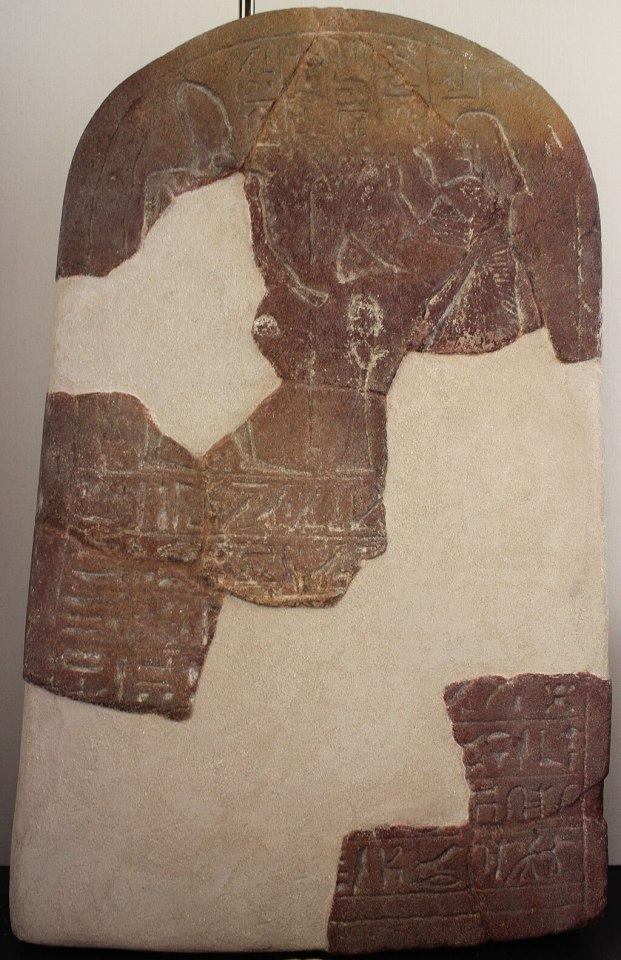
Stele of Set Sapouna (Baal Zephon) c. 1350 BCE Rash Shamra, Ugarit (modern Syria) Louvre Museum AO13176 A dedicatory stele by Maymi, the royal scribe, and former supervisor of the treasury, identifying the mountain/storm god Baal Zephon (Baalu Sapunu) with the Egyptian deity Set (Sutekh). Found within the temple of Baal-Hadad in Ugarit.
#baal#baal hadad#hadad#adad#beelzephon#set#seth#set deity#sutekh#canaan#canaanite gods#phoenicia#phoenician gods#aram#aramean gods#syria#syrian gods#levantine gods#hellenismos#mesopotamia#mesopotamian gods#ugarit#ugaritic gods#egypt#egyptian gods#kemeticism#kemetic#kemetic polytheism
63 notes
·
View notes
Note
Food for thought in this trying times (me I need to destress a little so I just came here for shelter)
Some sort of child AU where the gods are still young and act like little kids, El is doing his best to control them all, and then there is Baal who secretly sneaks out —while they all play hide and see— to meet with one of the gods from another isolated pantheon, Yahweh. They are both storm gods, so they get along really well. (And you know how there's often a male god and a female god that represent the same thing, Baal says that since he will become the most popular god out there, Yahweh should become his 'female' counterpart and partner lol. And Yahweh is like nu uh I will become more a more popular god than you!)
Oh no, that's just too adorable 🥺
Staying accurate to Canaanite 'canon,' that would make a lot of sense. Yahweh is his own entity from a related but not same culture (He says He is the 'King of the Israelites' for a reason), so if Ba'al comes sneaking on over teasing him about how they're going to grow up and 'be married,' obviously Yahweh has to be like 'okay, but if you ever betray me or take another wife, I'm breaking up with you.'
And like what, Ba'al is just gonna let that happen for free? He insists, even tells Yahweh he must do the same thing or else it's fucking over and he's going to pillage every village Yahweh can ever build,
So the two do that cute young child thing of kissing on it. Now, you sort of have to bake in an arc where they get separated for some reason, most likely it being Ba'al who goes to war while Yahweh 'trains' beneath El to be the God he's supposed to be,
But they keep trying to marry Yahweh off so he can create 'his own pantheon' though he will not fucking have it. He turns down every single suitor (mainly women) with such ferocity that it starts stressing El out until Ba'al comes back,
Resulting in the first thing they do when they reunite is consummating. Well, from what I understand, Yahweh only has one true-born son (Jesus or Michael, take your pick), but if we veer off the beaten path, let's assume he and Ba'al birth many sons, not necessarily gods, but maybe. . . .
. . .wait for it. . .
. . .the first prophets of the Old Testament (Abraham, Isaiah, Moses, Noah, etc)
OR, if you really want, we can cannibalize the "canon" Canaanite mythology that Ba'al has three goddess-daughters with Anat and just throw Yahweh in there instead because that's highkey what my ass has been doing since I started writing them 👼🏽
#the author answers#canaanite gods#baal hadad#yahweh#mlm textpost#bro i am disrespectful when it comes to the Caananite family tree 'cus i be sidelining Anat so Ba'al can get in Yahweh's guts#i want it to happen so bad omg#and you are always welcome to send asks or say hello#i like to talk and i love to teach#i hope you have a better day and that this lifted your spirits some!
8 notes
·
View notes
Text
I'm here for goth girl Anat
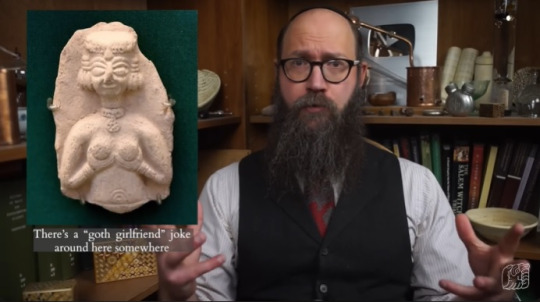
Are you?
#esoterica#anat#canaanite mythology#canaanite polytheism#ugaritic mythology#ugaritic polytheism#paganism#war gods#esoteric shitposting
13 notes
·
View notes
Text
According to my scant, second hand knowledge of the Jewish religion (idek the proper name, don't @ me), Catholicism, and Christianity, back when Jews were nomads, way before they settled down in one place, their god Yahweh was, in two words, a vicious dickhead of a storm god, and only after they settled down in Canaan did they try to calm him down by doing the theological equivalent of murdering the real wise and kind skydaddy god, El, blessed be his name, and then have Yahweh wear his flayed skin like some sort of grotesque mask and eat the rest, and that frankly goes pretty hard. Anyways I'm SOOO co-opting that into my writing, imagine worshipping the god that killed the supreme skydaddy and ate his corpse to gain his might. That's baller.
Edit: After further study, I have concluded that Yahweh was once an aspect of Qos, a mountain, weather and war god of the Edomite people. The ancient Israelites of Canaan then did a systematic eradication of every other god in the greater Canaan religion, including such gods as El and Asherah, Yam and Lotan, Arsu and Azizos, Aglibol, Malakbel, Yahribol, Bel, and Ba'al Hadad. In their shame after the crushing of the ancient Jewish kingdom under Babylon, the Jews, jealous in the banning of sacrifices to Yahweh, later wrote into their own Bible the banning of sacrifices to all gods. But Yahweh took sacrifices, and Yahweh took sacrifices in human infants, for Yahweh was a fellow Canaanite god just like the rest of them.
Edit 2: THIS POST IS ABOUT THE PRE-JUDAISM YAHWIST CULT OF THE ANCIENT CITY STATE OF ISRAEL AND HOW IT BECAME THE MODERN CULTS. Having to add this because some fucking [REDACTED] in the comments think that literal historical facts (with added hyperbole) is antisemitic somehow. They know who they are.
#worldbuilding#gods#worldbuilding religion#truth is stranger than fiction#but fr tho the ancient canaanites were nomadic raiders#and bandits too#and their god were similarly violent#only after they settled down did they try to smooth things out#the draft was made before oct 7#in the spirit of keeping it straight i won't comment on the newer news here#jewblr#jumblr
77 notes
·
View notes
Text

El, the original Semitic creator god. An omnipotent creator, all things emerged from his hands. With Reality bending around his fingers, El is the highest authority across the pantheon, Even greater than the king of the gods Baal. The specifics on how El created the universe is still a mystery, but it is believed that he created the cosmos from the nothingness around him. After creation, El investigated the seas of Chaos that flowed from him, among the waves bobbed the heads of two women, that of Asherah and Raḥmayyu. Curious, El took them home and began cooking a bird, he asked them that once the bird was done if they could call to him as either father or husband, whichever one they picked he would behave as such, once the bird was done they called to him as husband. The following intimate night resulted in the birth of Shachar and Shalim, the gods of Dusk and Dawn. From his coupling with his two wives the pantheon of Canaan was born. Baal, Mot, Yam, Astarte, Anat, all of them came from the light of El. El oversaw and organized the race for the throne of the king of the gods, a competition in which his children could campaign to be bestowed the throne by El. During the race, the sea god Yam gained much influence, with him having the favor of El’s wife Asherah. However, during a gathering of the pantheon, Yam insults the entire pantheon including his own father El. But following a duel with Baal, Yam is defeated and forced to pull out of the race, leaving Baal to be crowned the king of the gods. With the help of Asherah, Baal is able to convince El to authorize the construction of a palace. However during a feast ushered by the newly appointed Baal, the death god Mot consumes him. El joins the universe in grieving the loss of his son. Despite being in the throes of grief, El dreams that Baal is still alive. Elated, El sends the sun goddess Shapsh to rescue his son. After his return Baal once again begins combat with Mot, that is until El steps in, threatening Mot that if he continues he’d annihilate him, causing Mot to back down. In a separate myth, during a feast of the gods, El gets outrageously drunk, but is ultimately healed.
El was an incredibly important deity, it cannot be understated just how important he was. His worship evolved and transmitted into many different gods, the Syrian Dagan, the Mesopotamian Anu Enlil and Marduk, the Hurrian Kumarbi, and his Hittite form Elkunirsa. El also corresponds to the Chinese Shangdi, the Zoroastrian Ahura Mazda, and the Slavic Rod and Svarog, with some of these gods possibly developing out of El. The Egyptian Ptah also has traces of El within his worship, as both share the epithet of “Eternal”, however among the Egyptians Kothar-wa-khasis was supposed to be cognate with Ptah. The most important theological relation El holds is his connection to the modern Abrahamic God, as El is the direct originator of the Deity. Originally Known as Yhwh, this deity originated as the Israeli form of El, similar to how Dagan was the Syrian form of the god. Yhwh was a divine warrior god married to Asherah, with their children being the other Canaan gods like Baal and Astarte, all these deities held divine messengers known as Malak. Yhwh was the foremost worshipped deity in ancient Israel, with the vast majority of prayer being offered to them. However during the subjugation of Israel under Babylon, the monotheistic Yhwh emerged as a form of resistance against their Babylonian rulers. The deities of Canaan were demonized and absorbed into Yhwh and his Malak, who became the angels of Abrahamic faith. The naming scheme of angels keeps their relation with El, as seen in Raphael the oldest name among the angels. The modern God shares many of their other titles with El, including El Shaddai, Elohim (the term referring to the Canaanite pantheon meaning “the children of El), and El Elyon. Phoenicia also held Canaan’s gods and myths, including El. However due to being conquered by the Greeks, Phoenicia was forced to Hellenize their culture, with it essentially becoming Greek mythology with a Canaanite coat of paint. This is seen most prominently in their recorded creation myth, in which El wasn’t the creator or original god, but rather the son of the sky and earth who in turn were created by El Elyon, which was originally a name for El himself. El is later deposed by Baal, obviously this myth is heavily based on the greek theogony, with El taking the place of Chronus and Baal with Zeus. My personal theory on the origin of El is that he may have developed from the African creator gods, like Ra, Nyame, Amma, and even possibly Zanahary. El held many titles, such as “the bull god”, “Creator of creatures”, “the gracious one”, “father of the gods” and “father of man”. In many god lists from ancient Canaan, El is preceded by Ilib, a character not mentioned in any other texts. Ilib’s placement has led to the idea that it was possibly a forerunner deity to El, however no other texts support this, and the belief that El was the original deity contradicts this. Ilib is used as a term to refer to dead ancestors in Canaan, so most likely the Ilib in the god lists refers to the familial dead ancestors. The word El is used as a term to denote a deity in Canaanite language, evolving from Il, in texts however El himself is distinguished from this word by using ha El meaning “the great El”.
#art#character design#mythology#deity#creature design#el#el elyon#el shaddai#creator god#supreme god#animal god#bull god#canaanite mythology#semitic mythology#abrahamic religions#semitic#canaan#levant
10 notes
·
View notes
Text

[CANAAN] Anat beautifying herself for the festivities at Baal's new palace
#anat#canaan#canaanite myth#canaanite god#goddess anat#my art#doodl#look ok i know im borrowing some hathor iconography but look. listen. ok.#red dress like this chosen bc of that one egyptian popular image of her on the throne w axe and spear#horns bc duh#it makes sense to me!
159 notes
·
View notes